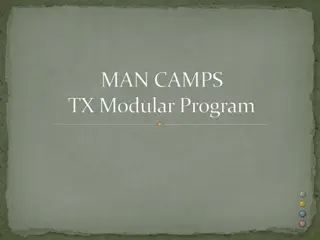Radon Concentrations in New-Built Swedish Dwellings: Findings from International Radon Symposium
Large decrease in radon concentrations observed in newly built Swedish dwellings, with data analyzed from 1950 to 2016. Dependencies between building year, foundation type, ventilation, and radon levels were evaluated. Results compared against the Swedish reference level of 200 Bq/m3. Measurements in single-family and multi-family houses show variations based on building year ranges. No significant increase in radon levels observed in new buildings constructed between 2002-2004. Insights presented at the 2018 International Radon Symposium.
Download Presentation

Please find below an Image/Link to download the presentation.
The content on the website is provided AS IS for your information and personal use only. It may not be sold, licensed, or shared on other websites without obtaining consent from the author.If you encounter any issues during the download, it is possible that the publisher has removed the file from their server.
You are allowed to download the files provided on this website for personal or commercial use, subject to the condition that they are used lawfully. All files are the property of their respective owners.
The content on the website is provided AS IS for your information and personal use only. It may not be sold, licensed, or shared on other websites without obtaining consent from the author.
E N D
Presentation Transcript
Large decrease of radon concentrations in new-built Swedish dwellings by Tryggve R nnqvist, Radonova tryggve.ronnqvist@radonova.com 2018 International Radon Symposium
Large decrease of radon concentrations in new-built Swedish dwellings Dependencies between building year and radon levels in Swedish dwellings were evaluated: Data from measurements analyzed during 2015-2017 Dwellings with building years from 1950 until 2016 Dependencies of foundation and ventilation type were investigated Data were compared against the Swedish reference level of 200 Bq/m3 (5.3 pCi/l) 2018 International Radon Symposium
Large decrease of radon concentrations in new-built Swedish dwellings Building year Number of measurements Average radon conc. (pCi/l) Highest value (pCi/l) Above 5.4 pCi/l 1950-1980 (all) 7495 5.0 116 33 % 1950-1980 (blue concrete) 1886 6.8 90 53 % 1950-1980 (no blue concrete) 2519 4.4 110 27 % 1980-2000 8099 2.4 123 11 % 2000-2010 2332 1.7 52 6.1 % 2014-2016 2255 1.1 165 2.0 % Measurements in single-family houses 2018 International Radon Symposium
Large decrease of radon concentrations in new-built Swedish dwellings Building year Number of measurements Average radon conc. (pCi/l) Highest value (pCi/l) Above 5.4 pCi/l 1950-1980 (all) 10080 3.4 124 20 % 1950-1980 (blue concrete) 2824 5.2 48 38 % 1950-1980 (no blue concrete) 1568 2.5 124 10 % 1980-2000 8691 1.4 56 5.1 % 2000-2010 3170 1.3 38 3.9 % 2014-2016 3942 0.8 41 0.3 % Measurements in apartments in multi-family houses 2018 International Radon Symposium
Large decrease of radon concentrations in new-built Swedish dwellings Single-family houses = Sm hus Multi-family houses = Flerbostadshus Number of new-built dwellings in Sweden (source: SCB) 2018 International Radon Symposium
Large decrease of radon concentrations in new-built Swedish dwellings Measurement year Number of measurements Average radon conc. (pCi/l) Highest value (pCi/l) Above 5.4 pCi/l 2005-2006 988 1.9 136 6.6 % 2007-2008 967 1.9 106 5.7 % 2009-2010 551 2.1 43 8.5 % 2011-2012 240 2.3 46 10.4 % 2013-2014 227 1.8 18 9.7 % 2015-2016 154 2.0 52 6.5 % New buildings: are radon levels increasing with time? Measurements in single-family houses built 2002-2004 No statistical significant change can be seen, Kruskal-Wallis test (p-value = 0.4159) 2018 International Radon Symposium
Large decrease of radon concentrations in new-built Swedish dwellings Crawl space Basement Split level Slab on grade Radon levels and foundation types in single-family and multi-family houses 2018 International Radon Symposium
Large decrease of radon concentrations in new-built Swedish dwellings Today, most Swedish single-family houses are built with Slab on grade as foundation type and very few new houses have Basements. 2018 International Radon Symposium
Large decrease of radon concentrations in new-built Swedish dwellings Slab on grade together with Basement are the dominating foundation types in multi-family houses 2018 International Radon Symposium
Large decrease of radon concentrations in new-built Swedish dwellings Single-family houses Multi-family houses New single-family houses with mechanical or balanced mechanical ventilation have in average much lower radon concentrations than houses with only natural ventilation. Radon levels and ventilation types 2018 International Radon Symposium
Large decrease of radon concentrations in new-built Swedish dwellings Today, very few single- family houses have only natural ventilation, mechanical or balanced mechanical ventilation are dominating. 2018 International Radon Symposium
Large decrease of radon concentrations in new-built Swedish dwellings Today, most new multi- family houses have balanced mechanical ventilation. 2018 International Radon Symposium
Large decrease of radon concentrations in new-built Swedish dwellings Possible explanations for the decreased radon concentrations in new-built Swedish dwellings : Better and more uniform building practice. Mechanical or balanced mechanical ventilation are used in almost all new Swedish dwellings. Very few new single-family houses are built with basement, the dominating foundation type is slab on grade. 2018 International Radon Symposium
THANK YOU !! Tryggve R nnqvist +46 706591708 tryggve.ronnqvist@radonova.com 2018 International Radon Symposium























